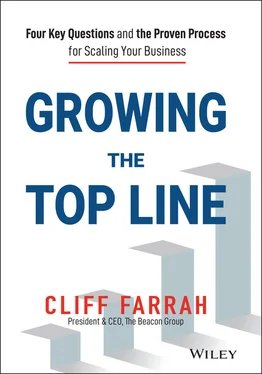I am a really big James Klein fan. And he’s representative of the people I sought out to participate in this book.
Throughout this book, I’ll share stories from varied perspectives at a broad array of companies. Companies matter, because they are all very different. Companies are literally “creatures” that are organically composed of people with a shared value system. You can’t say “Apple announced today…” and believe that it’s only a corporate act. Any announcement has been approved by legal, and not just legal: Katherine Adams, Apple’s General Counsel (at the time of writing). It was also likely approved by Luca Maestri, Apple’s CFO (at the time of writing), and I’m pretty sure that Tim Cook signed off as well. Investor relations, marketing, production, and sales all had to sign off on it, and because of the announcement lives are in flux. People will be hired, companies will be bought, people will be fired. Whenever I discuss the success of a growth strategy of a large company, I like to use the 50× rule. Take the number of direct staff involved in executing a strategy and multiply than number by 50. That’s how many people within the company it will take for a plan to succeed, and any one of them can potentially cause it to fail.
This book is meant to serve as your playbook to develop clean, clear, effective, pragmatic, and executable growth strategies. It’s for both new and existing practitioners of our art who aspire to become scientists of the discipline. Through the use of parable, framework, and process, my goal is to educate you about the method used by some of the most successful companies in the world. This method includes organic and inorganic growth, regional and global footprints, large‐scale enterprise, and entrepreneurial ventures.
The truths of growth are physical laws that we are all bound by. Ideally, you read this because you want to learn, but even if you’re being forced to read this for class, you’ll learn something that could create a market of billions for you someday. So, open your mind, be ready to think, and enjoy learning from some of the best and brightest business minds in the world as they tell you their story. This is incredibly fun stuff, and if you are lucky enough to be responsible for this function, then you know it’s pretty rarefied air and should be savored.
CHAPTER 1 The Growth Matrix and the Four Key Questions
Growth is an infinite game, with the revenue line limited only by your ability to convince new or existing customers to buy the products or services you currently or will produce.
Ever think about how to bound the question of growth? I’m a growth strategist, so I worry quite a bit about the sources of growth. Where does growth come from?
Turns out the question has a simple answer.
All revenues come from two variables: (1) customers and (2) the goods/services they buy. Full stop. It’s really that simple: who buys and what they buy. Every business, from the first fish seller bartering his daily catch for salt to the world’s biggest consumer goods company, grapples with these two fundamental questions. Let’s talk about customers first.
There are all kinds of customers and they have different values to companies when considered over a time period.
Kevin Watters is blazing fast in every sense. Physically, he’s a marathoner who is a top competitor for his age group. He processes information quickly and insightfully. He is quick to offer his help, and his fast‐tracked career is an incredible success story. Currently retired and an adjunct professor at Tulane’s Freeman School of Business, Kevin started his career in consumer packaged goods working for Proctor & Gamble, where he received his “MBA on top of an MBA” through their training program. He then went on to dip his toe in entrepreneurial waters, got married to his amazing wife, Fern, had their first child, and then he needed to go back into the corporate world. He found his way into the world of online banking in 1999 and never looked back. He joined Bank One, and was noticed by Jamie Dimon, who asked him to take over as President of their Consumer Internet Group. From there Kevin took over wholesale banking. When Bank One was acquired by JPMorgan Chase, he took over as CEO of business banking and grew it to over a billion‐dollar business. Being one of the few businesses that managed credit well through the Great Recession, he was asked to fix the wreckage that was the mortgage portfolio, which he did. In his final role at JPMorgan Chase, Kevin took over as CEO of their credit card business. We talked about the true value of customers in the world of financial services.
Banking is a little bit interesting. It doesn’t matter what age you are when you go into Starbucks and you buy a latte. Whether you’re 25 or 65, your latte is the same price. Well, in banking chances are if you’re 65, you’ve got a lot more money than when you were 25. So part of the game is for your existing customers to stay with you, with the more money they have. In your 30s you’re borrowing for your mortgage, in your 40s, your investment account is growing so great, let’s make sure we’ve got your mortgage and your investment account. You know in your 20s, I want to make sure you’ve got a credit card and I have your checking account, but I’m getting everything else as you grow. Within your life I’m growing with you, and then I’m getting your retirement account. I’m growing up with you, which is a little bit different than other products where you know, like you’re buying your latte if you’re 25 or 65, is still $4 and thanks. Much different in the banking world.
I loved the insight Kevin’s example gave. This is just one industry. Every industry and business has their own version of this.
As strategists, there are a few important things to consider when you think about customers that I want to talk a bit about. Some basic rules of thumb:
All money comes from your customers.
All customers are not equal.
Customers buy differently.
All Money Comes from Your Customers
Sounds obvious, but unless you are a business owner, or tasked with top‐line growth, it is very easy for businesses to lose sight of this simple fact. Why? Because you get wrapped up in your everyday work process, and you can’t see the clear link between your customers and your paycheck. At Starbucks, it’s easy to see how customers fuel the business. It’s a direct transaction: A customer orders a latte, swipes a card, and gets a latte. Any employee can see how that customer relates to their paycheck.
However, in some industries there are indirect customers whom you serve. Healthcare is a great example. Depending on where you live in the world, most providers are reimbursed from either a public or private “payer” (insurance company). Money doesn’t come from patients, right? Well, ultimately, Medicare, Medicaid, and military insurance programs are funded through tax dollars. In those public programs, taxes come from the country’s citizens, who are, effectively, its customers. Private insurers are paid by employers or individuals, so even though it’s indirect, the customer still pays the bills. These are extreme examples, but you get the point.
We also have many clients who worry about their customer’s customer. That is, let’s say you manufacture a radio component that is part of the Tesla system. You aren’t really designing functionality for Tesla; you are designing for Tesla owners (the end users) or your customer’s customer. So even though your bills are paid by Tesla, without Tesla’s customer base you won’t get paid for very long. That means you likely work to understand the end user’s wants and needs. As we consider the source of all revenue – our customers – we have to be sensitive to the indirect trail that the money may flow through.
Читать дальше












